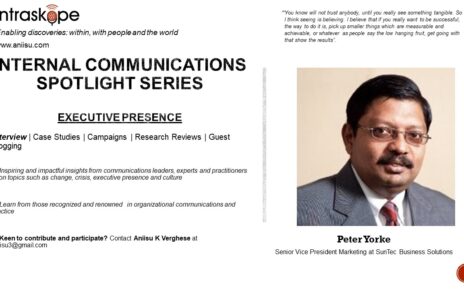Senior leaders often represent their organizations at external engagements as speakers or panelists. The expectation is to contribute to a discussion or share thought leadership insights on topics that matter. Here, the communicator’s role isn’t to help create content for marketing or branding or to make the leader look good on stage. It is very different.
There is a trust crisis sweeping across the world and leaders are expected to engage with integrity, communicate a trusting environment and share their own personal values. The role of the communicator is to help leaders appreciate the nuances of public communication, be consistent and get it right through their presentations. There are many factors at play in making effective presentations – understanding the context, researching the subject, crafting a presentation and messaging framework, creating content, prepping for the session and delivering it confidently. That is not all. Reviewing how you fared post-session can help you get better for future engagements.
Many investments go into addressing the tone of voice, stories, the delivery and the take-aways for audiences who attend these presentations. Considering most of these events have media representatives present, leaders can expect questions which they may not be fully prepared for. Often, it is important to also know what ‘not to say’ while at such formal interactions. After reviewing numerous presentations for leaders over the years, here are a few key suggestions that communicators can refer to while helping leaders be their best.
· Relevance: When leaders share insights or perspectives, it needs to be meaningful for the forum, the audience and connect to the organization’s point of view. Your organization’s brand images can be dented if the presentation is an exercise in self-promotion, pitches the company offerings or drives a ‘hidden’ agenda. The first 60 seconds are crucial to captivate attention. Therefore, your leaders need to be on point and interesting every time they speak.
· Context: Making the right connection with the topic is an important aspect of making great presentations. Attempting to link to the most current topics; for example, border tensions or trade tariffs can boomerang on the leader if placed out of context. When leaders exchange their presentations for simple words, they amplify their communication impact.
· Messaging: Sharing messages does not have mean a Power Point presentation. Ditching the slide pack can be a blessing. In the information age, what matters is the quality of ideas you are sharing. This comes with practice. The goal for your leader is to focus on the narrative, share stories and reiterate your key messages.
· Authenticity: Just showing up isn’t enough.When you leader speaks in ways that connects with his or her personal values they are viewed as trustworthy and their voice is considered credible. According to a study, authentic leaders are 50% more passionate, their visual delivery 34% more effective and messages 29% clearer than the average leader. Expressing a confident, connected and conversational approach can infuse authenticity in presentations.
· Preparation: It always helps to test your content internally before you face an audience who can have tough questions to ask. Helping leaders self-reflect on the presentation’s purpose, audience, their own perspectives, personal connection and current trends among others can improve outcomes. Practice is crucial for success and so is feedback. In one of my earlier assignments, a leader I worked with made it a point to do a ‘safe to fail’ session with a select group of partners and staff before he took it outside the organization. The session gave him sufficient feedback to tweak the content before exposing with other audiences.
Getting leaders who represent your business to be your brand ambassadors is essential to improve your organization’s standing. From researching to curating content, prepping to delivering brilliant presentations – the journey can be arduous for busy professionals. It is however, an investment you cannot afford ignoring.
What are your thoughts? Do share them here.
For more such articles, visit my Linkedin page: https://www.linkedin.com/in/aniisu/



